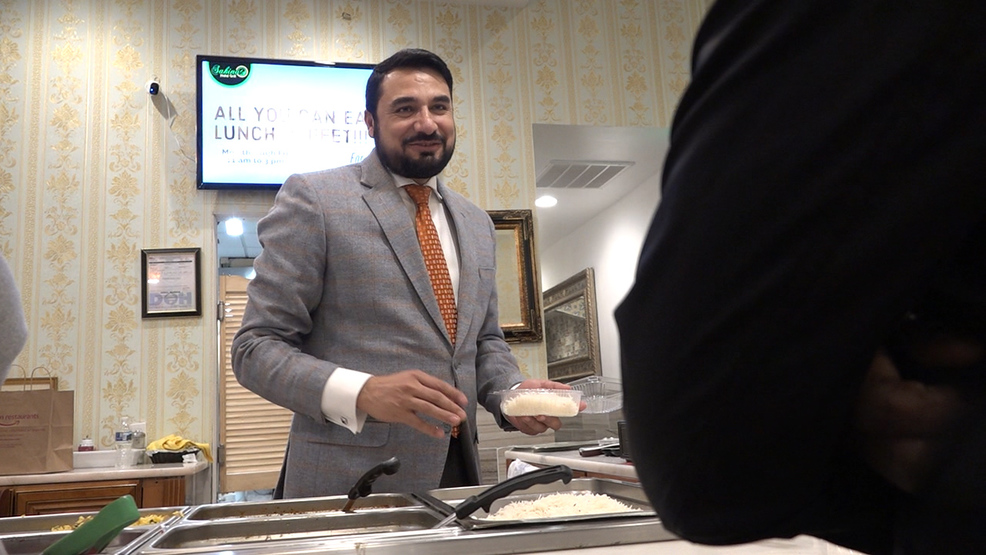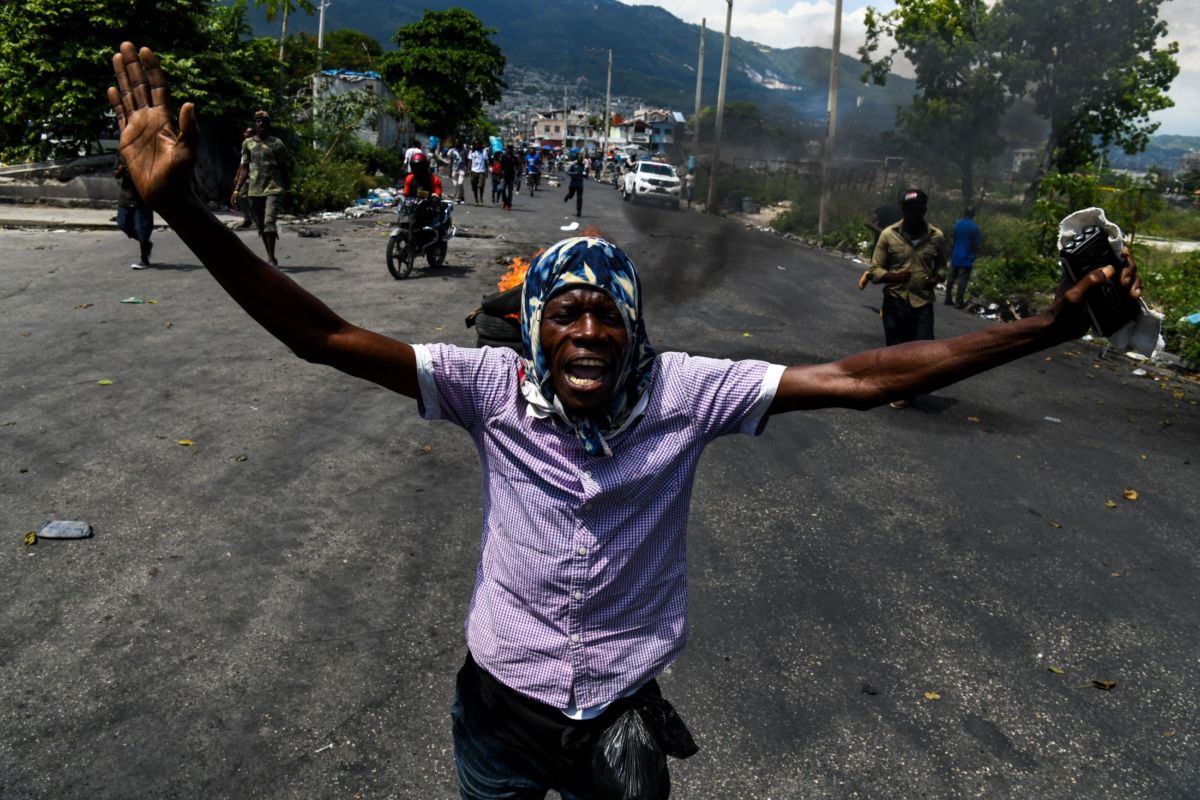Judi Lynn
Judi Lynn's JournalLocal Hero of the Month: Restaurant owner invites DC's homeless to dine for free
Local Hero of the Month: Restaurant owner invites DC's homeless to dine for free
1 day ago
Note from the editor: For the month of June, MSN is honoring Kazi Mannan, a Washington, D.C. restaurant owner who feeds the homeless for free. As our Local Hero of the Month, we are holding a fundraiser for the charity of his choice. Mannan has asked that we direct donations to Akhuwat USA, a 501(c)(3) nonprofit organization that provides interest-free micro loans to lift people out of poverty and build thriving futures. Click here to make a small contribution that can make an enormous impact.
Kazi Mannan remembers what it feels like to be hungry. Growing up in Pakistan as one of 12 children, he and his siblings often struggled to fill their bellies.
When he immigrated to the United States in 1992, he was surprised to see that many people in the most powerful country on Earth also didn’t have enough to eat. “I see this struggle of people looking for food through trash cans and it just took me to my own childhood memory of wishing I had a good meal,” he said.
He dreamed of opening a restaurant, and he vowed that if he did, he would try to help. Mannan is now the proud owner of Sakina Halal Grill, an elegant restaurant serving Pakistani and Indian favorites just blocks from the White House. One day after opening in 2013, he walked to a nearby park occupied by homeless people. He says he invited them to come have a free meal, and he was met with suspicious skepticism. Nevertheless, he convinced a few to join him, and they left happily surprised and well-fed.
He now estimates that he provides 16,000 free meals a year. He sees that number as a goal, not a liability, and he always meets it. He makes enough money from paying customers to support the meals he gives away. “Most restaurants just think about their profits, and they think if you let homeless people come in, it will ruin your business,” Mannan said. “I wanted to prove them wrong.”
More:
https://www.msn.com/en-us/news/causes/local-hero-of-the-month-restaurant-owner-invites-dcs-homeless-to-dine-for-free/ar-AADzCwn?li=BBnb7Kz

Kazi Mannan


Hope for the Homeless
Photos of Kazi as a young man, etc.
https://wjla.com/news/local/gallery/web-exclusive-incredible-story-of-dc-restaurant-owner-who-feeds-homeless-for-free#photo-1
Interactions Between The Ancient Maya And The City Of Teotihuacan Revealed By New Excavations
Jun 28, 2019, 10:05am
David S. Anderson Contributor

Panorama of Pyramid of the Sun. Teotihuacan. Mexico. View from the Pyramid of the Moon.GETTY
Earlier this month, Mexico’s National Institute of Anthropology and History announced new discoveries made by archaeologists working at the site of Teotihuacan, located outside of Mexico City. Teotihuacan was first occupied in 100 BC and grew to be one of the largest cities in the entire world before its collapse in AD 650. The new findings from this ancient city shed important light on the complex relationship that the people of Teotihuacan held with their Central American neighbors, the Maya.
For many decades, archaeologists have found occasional examples of Teotihuacan style artifacts and architecture at Maya sites leading to speculation about the relationship between these two cultures. Significant light was thrown onto that relationship in 2000 when epigrapher David Stuart published his interpretation of a hieroglyphic text from Stela 31, a monument from the Maya city of Tikal. This public monument seemed to describe the conquest of Tikal in AD 378 by foreigners with the backing of Teotihuacan.

View of majestic mayan ruins with green grass and trees at Tikal National Park in Guatemala near the border of Belize.GETTY
In the 4th century AD, Maya cities were still relatively small, and thus it was not difficult to imagine that Teotihuacan could have held some political or military influence over their neighbors, yet we still knew relatively little about the nature of the relationship between these two powers. The new findings announced by the National Institute of Anthropology and History, however, have revealed the presence of Maya people at Teotihuacan prior to the invasion of Tikal, thereby adding yet more layers of complexity to this story.
These new findings were presented by archaeologist Nawa Sugiyama of the University of California, Riverside, at the conference Descubrimientos recientes en Teotihuacan: excavaciones en la Plaza de las Columnas. Sugiyama, together with an international team of archaeologists, documented numerous signs of Maya presence in a group known as The Plaza of the Columns at Teotihuacan.
More:
https://www.forbes.com/sites/davidanderson/2019/06/28/interactions-between-the-ancient-maya-and-the-city-of-teotihuacan-revealed-by-new-excavations/#7d556a5c7d76
From Cyber War to Omnicide?
Fearless Muckraking
Since 1993
JUNE 28, 2019
by PAUL ATWOOD
Will the Justice Department and all those calling for the heads of Chelsea Manning and Julian Assange now demand that the publishers of the hallowed New York Times be punished for their transgression of revealing our government’s cyber warfare against Russia? The front page article is titled “U.S. Buries Digital Land Mines To Menace Russia’s Power Grid.” Many citizens undoubtedly feel that this is just payback for the long decreed turpitude of the Russians for interfering with our “democracy.” Of course there is nothing new about this…the cyber warfare that is. One could make the case that such has been ongoing and deepening since at least World War I and in some fashion probably as soon as electronics like the telegraph and telephone were invented. Modern computer science propels this latest installment of the deadly Great Game to new altitudes, however, and, unlike the case for nukes, there are no international treaties or agreements that bind nations in any regard when it comes to waging what is rapidly evolving into extremely hazardous subterranean warfare that can only increase the probability of far worse.
Consider the scenario wherein an entire major city’s electric grid is brought down for three days or a week or more as the U.S. has undoubtedly caused in Venezuela and may soon in Iran. How many are dying in Caracas owing to a lack of potable water, or food poisoning due to spoilage, or in hospitals without power? Were such happening here in the states the government would surely see this as an act of war and would respond with terrifying violence. How do the Russians view matters? Is an escalation looming? When will such “gaming” result in some extreme catastrophe that does intensify to all-out war?
Are we able to pause and reflect seriously on the dire consequences of our collective behavior – or passivity? The globalized capitalist way of life and the parallel evolution of industrial-technological mass murder among humans has led us to a glaring potential for our species extinction. The evidence surrounds us yet few seem to notice. There are two major likelihoods for this end game. One is global warming and its climate, social and economic upheavals that could easily lead to the other, namely nuclear war. Many, far too many of us, ignore these looming terrors precisely because they are so petrifying. Yet no messiah is waiting in the wings. Collectively we awaken to the conditions our own apathy has nurtured about the matters we refuse to face or climactic events are sure to take their course. The extremities in which we now find ourselves can be traced directly to economic and military policies pursued by Europeans and Americans for the last half millennia but now are being duplicated planet wide. As the most powerful entity ever to bestride the globe U.S. policies have long contributed to the Catch-22s in which we are now ensnared and at present American policies threaten to ensure that the worst will occur.
The late 19th Century constituted the take off point of modern American capitalism and the origins of American economic expansion, militarism and armed conquest, all coated with idealism and dishonesty for the very real suffering imposed upon the newly subject peoples, particularly in the all but hidden Philippine War of 1898-1902 where at least 200,000 civilians died, the greatest number up to the time… but not for long. The Filipinos had been promised full independence once the U.S. defeated Spain. Why did they not realize that assurance? As Senator Albert Beveridge, a close ally of Theodore Roosevelt and the imperialists, bluntly put matters, “The Philippines are ours forever…and just beyond lie China’s illimitable markets…we will not renounce our part in the mission of our race…trustee under God, of the civilization of the world…China is our natural customer…the Philippines give us a base at the door of the East”
More:
https://www.counterpunch.org/2019/06/28/from-cyber-war-to-omnicide/
The Cuban Revolution and the National Bourgeoisie
JUNE 28, 2019
by CHARLES MCKELVEY

The demand of the Cuban-American Right for full implementation of Title III of the 1996 Helms-Burton Law, announced by the Trump administration on April 17, is rooted in the 1959-1961 conflict between the Cuban Revolution and the Cuban national bourgeoisie; when the Revolution in power, with the overwhelming support of the people, took necessary decisive steps that the national bourgeoisie interpreted as incompatible with its fundamental economic interests.
The relation between the Cuban Revolution and the Cuban national bourgeoisie did not begin as conflictual. Representatives of the national bourgeoisie were allied with revolutionary organizations in an anti-Batista coalition, and lawyers tied to the national bourgeoisie constituted the majority of the ministers of the Revolutionary Government established in early January 1959. These political dynamics reflected, in part, the Revolution’s goals of economic diversification and industrial development, which Fidel Castro conceived as ideally including the national industrial bourgeoisie. Reinforcing this orientation, a liberal sector of the bourgeoisie expressed a desire to develop toward an independent national bourgeoisie. Accordingly, the Revolutionary Government during its first eighteen months took no action against the class interests of the national bourgeoisie.
The first property expropriations were enacted on February 28, 1959. As confiscations of the property of Cuban nationals associated with the Batista regime, they were not directed against the interests of the national bourgeoisie as a class. The Batista dictatorship of 1952 to 1958 was characterized by blatant corruption, repression, and brutality, and the popular thirst for justice could not prudently be ignored by the Revolutionary Government. The confiscated properties were converted into public buildings, such as primary schools, day care centers, medical clinics, multiple housing units, and embassies.
The second act of expropriation was the nationalization of large-scale agricultural lands, making no distinction between foreign-owned and Cuban-owned land. The Agrarian Reform Law of May 17, 1959 adversely affected the interests of foreign capital and the national estate bourgeoisie, but it did not directly affect the interests of the national industrial bourgeoisie. Agrarian Reform was made necessary by a neocolonial situation defined by extensive foreign ownership of land, by concentration of land, and by peasants working on land they did not own. The Law set the maximum quantity of land per proprietor at 406 hectares; and it provided for compensation for expropriated lands in the form of twenty-year bonds, with its value based on what the owners had declared in tax reports. The expropriated land was used to form peasant cooperatives (mostly in sugar) and state-managed agricultural enterprises (mostly in rice and cattle); or it was distributed to peasants, who thus became small independent farmers. The nationalization of agricultural land facilitated a significant increase and diversification in agricultural production, primarily as a result of the cultivation of previously unused land, which had been purchased as financial speculation.
More:
https://www.counterpunch.org/2019/06/28/the-cuban-revolution-and-the-national-bourgeoisie/
15-year-old oil spill thousand times worse than rig owner's estimate
Study: 380 to 4,500 gallons of oil flow daily
By: Harmeet Kaur, CNN
Posted: Jun 29, 2019 03:02 PM CDT Updated: Jun 29, 2019 04:06 PM CDT
(CNN) - For 15 years, oil from one particular spill has been leaking into the Gulf of Mexico.
A new federal study estimates that each day, about 380 to 4,500 gallons of oil are flowing at the site where a company's oil platform was damaged after a hurricane. That's about a hundred to a thousand times worse than the company's initial estimate, which put the amount of oil flowing into the ocean at less than three gallons a day.
The report, released this past week and written by scientists at the National Oceanic and Atmospheric Administration and one at Florida State University, also contradicted assertions from the Taylor Energy Company about where the oil was coming from.
The leak started in 2004, when an oil platform belonging to the Taylor Energy Company was damaged by a mudslide after Hurricane Ivan hit the Gulf of Mexico. A bundle of pipes and wells sank to the ocean floor and became partially buried under mud and sediment.
More:
https://www.channel3000.com/news/15yearold-oil-spill-thousand-times-worse-than-rig-owners-estimate/1090483207
Key lawmaker wants U.S. to invade Venezuela to counter Cuba's influence
BY ALEX DAUGHERTY
MAY 23, 2019 04:00 PM
WASHINGTON
A U.S. senator and former presidential candidate said the U.S. military should invade Venezuela if Cuba does not immediately remove its security forces from the country, calling Cuba the Western Hemisphere’s version of Iran.
In a Wall Street Journal op-ed posted online Wednesday, Sen. Lindsey Graham, a South Carolina Republican who leads the Senate Judiciary Committee, favorably compared potential military action in Venezuela to the U.S. invasion of Grenada in 1983, an operation that lasted about a week and led to the overthrow of the Caribbean nation’s military-run government.
“I think the military option has to be real, I think the ultimate solution is getting Cuba out,” Graham said in an interview with McClatchy. “If Cuba goes, Maduro goes and we have a history of standing up to Cuban intervention in the past and this is a defining moment for the Trump presidency in terms of how they deal with Cuba.”
Graham’s statements are the most specific call for military action in Venezuela from a sitting member of Congress. Florida Sen. Rick Scott has called for the U.S. military to facilitate the delivery of humanitarian aid in Venezuela and a naval blockade of Cuba to cut off the ongoing oil trade between Cuba and Venezuela.
More:
https://www.mcclatchydc.com/news/politics-government/congress/article230744889.html




Preach it, Porky, preach it good. It's Mental Health Week.
Washington Meddling in Haiti Neglected by US Press

A demonstrator shouts slogans during a protest march against the ruling government in Port-au-Prince on June 13, 2019.
CHANDAN KHANNA / AFP / GETTY IMAGES
BY
Jane Regan, FAIR
PUBLISHED
June 29, 2019
Tens of thousands marching in the streets nationwide to denounce government corruption, reports of police and gang violence and murder and a downwardly spiraling economy. Calls for the government to step down.
If this were Venezuela, as recent FAIR analyses pointed out, elite media journalists and commentators would be all over the story. After all, they’ve been endorsing Washington’s blatant and repeated imperialist designs and interventions in that country for over a decade.
But this is not Venezuela. It’s Haiti.
Not that Washington has always opposed regime change in the world’s first black republic. A decade ago, presidents Bush père et fils approved and backed coup d’états twice, in 1991 and 2004, against Haitian President Jean-Bertrand Aristide, a left-wing populist chosen in the country’s first free elections. As with Iran and Venezuela, those were what The Intercept’s Jeremy Scahill (2/20/19) called “Regime Change We Can Believe In.”
But unlike Aristide, and unlike Venezuela’s President Nicolás Maduro, President Jovenel Moïse is Washington’s “man in Port-au-Prince.” He was hand-picked by Michael “Sweet Mickey” Martelly, the previous Washington-approved president, and had pledged to follow his “Haiti Is Open for Business” neoliberal policies.
More:
https://truthout.org/articles/washington-meddling-in-haiti-neglected-by-u-s-press/
Colombia: where performances of blackface continue
29 Jun 2019
Symeon Brown
Reporter
The tradition of blackface, where white people put on dark make-up to caricature black people, is now widely condemned as racist and offensive.
But that’s not the case everywhere.
In Colombia, performances of blackface continue. And what makes them different is that they are carried out by people descended from the country’s African slaves.
Video at link:
https://www.channel4.com/news/colombia-where-performances-of-blackface-continue
A 19th-century fortified line in Cuba is a lesson for Trump - walls divide but are not impenetrable
The history of the Trocha shows how barriers can split nations in damaging ways.
Yesterday · 11:30 pm
Alberto P Marti, The Conversation
Despite the US administration’s renewed interest in Cuba, including new travel restrictions, few have paid attention to a little-known, but telling, historical episode: the island’s 19th-century military Trocha. This massive fortified line was a Spanish attempt to contain the Cuban independence rebellion by splitting the island in half – and provides worrying lessons about the potential impact of US President Donald Trump’s “great, great wall” along the US-Mexico border.
The Cuban struggle for independence was a 30-year-long process that started in Eastern Cuba in 1868. That year, a handful of white landowners in the East of the island freed their slaves and took up arms against Spanish colonial rule. Until then, and despite the dissatisfaction with high taxation and their limited say in Spanish colonial affairs, Cuban elites had largely remained loyal to Spain.
Eighty years earlier, the 1791 revolution in neighbouring Haiti and the establishment of the first independent black republic there, had sent huge shock waves across the region. But with Haiti devastated by the war and no longer the world’s largest producer of cane sugar, the Cuban elite saw an opportunity to take Haiti’s economic place.
By the late 1860s, Cuba’s multi-million dollar sugar industry was producing nearly 40% of the world’s sugar cane. This economic miracle brought rapid development and political stability to the island. But there was a serious flaw: it was absolutely dependent on slave labour.
More:
https://scroll.in/article/928728/a-19th-century-fortified-line-in-cuba-is-a-lesson-for-trump-walls-divide-but-are-not-impenetrable
Editorials and other articles:
https://www.democraticunderground.com/1016234740
Peru's House of Cards: Odebrecht scandal has engulfed the country's political class
June 27, 2019 8.33am EDT
Pervasive and endemic corruption is a way of life in Peru – what the late Peruvian scholar Alfonso Quiroz described as an enduring “history of unbound graft”. So the fact that Peru is in eye of the storm of the biggest corruption scandal in modern Latin American history is hardly surprising. But, even in a region prone to theatrical political drama, the scandal has ensnared and toppled those in the highest political offices in Peru.
A Netflix-worthy tale of political intrigue has unfolded: one president Pedro Pablo Kuczynski (2016-18) resigned and is currently under house arrest. His predecessor, Ollanta Humala (2011-16) and his wife Nadine Heredia remain in preventive detention.
Meanwhile, former president Alejandro Toledo (2001-2006) – a Stanford-educated economist and the first elected indigenous president of Latin America – is in California fighting extradition to Peru after an arrest warrant was issued in 2017 on charges of bribery. And, shockingly, on April 17 2019, two-time president Alan García (1985-1990 and 2006-2011) and leader of the oldest political party in Latin America, the American Popular Revolutionary Alliance (APRA), refused to surrender to police and committed suicide.
The downfall of these leaders is symptomatic of the demise of an entire political class. In fact, of all the countries affected by the so-called Odebrecht scandal, Peru is perhaps the only country where the wheels of justice are truly turning – in this case, literally, into indictments of a once untouchable sphere of people. But why is the judicial system working so well in Peru of all places?
More:
https://theconversation.com/perus-house-of-cards-odebrecht-scandal-has-engulfed-the-countrys-political-class-118793
Profile Information
Member since: 2002Number of posts: 160,516